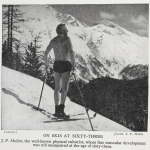On Writing “The Origins of Western Mind-Body Exercise Methods”
by Jonathan Hoffman
In my eyes, honest sharing and honest challenging lead to unselfishness and clearer understanding. Pi-lates Intel has set this example in our field and therefore I was honoured when Brett read the recent article Phillip Gabel and I co-authored (you can read it here), and invited me to present and summarise it for the Pilates community.
Our historical research project studied six early modern turn of the 20th century mind-body exercise pioneers – Checkley, Müller, Alexander, Randell, Pilates and Morris. The methods they developed were based upon the same universal exercise philosophy, and prescribed a similar practice. Therefore, in the paper they were regarded as members of a common cultural movement we named The Modern Mind-Body (MMB) Movement. These charismatic pioneers typically ‘discovered’ their methods following a personal history of a weakly body or trauma and a spectacular healing process. At the dawn of moderin-ty, these six mind-body pioneers found a unique liberty to create their methods without the religious, political or commercial connotations of the past; the exercises were simply harmonious functional hu-man movements combined with breathing and relaxation techniques learned from observations of ani-mals in nature. The MMB pioneers were mainly influenced by the 19th century physical-culture gym-nasium movement and were inspired by the harmony of ancient Greek figures.
It is customary to think that early modern methods like Pilates and Alexander were strongly influenced by Eastern mind-body methods like yoga, xi kong and tai chi. Interestingly, our research found that Eastern methods did not directly influence the creation of MMB methods, simply because at the time they were not around to do so. An exception was English obstetrician Kathleen Vaughan, who returned from India around 1911 after observing and later documenting the connection between an outdoor ac-tive lifestyle and ease of childbirth in Punjab.
Our research started by chance. During a seemingly mundane internet stroll, I stumbled upon this online vintage exercise video clip. In the video, a young instructor provided beautiful, flawless demon-strations of what I thought was a really cool Pilates class in a relaxing garden environment. I was amazed by the soft, calm, relaxing and feminine atmosphere and how the familiar exercises were taught and performed so accurately and harmoniously. The credit however was not given to Pilates as I ex-pected but to two unknown names: Minnie Randell (misspelled Randall) who developed the exercises and Barbara Mortimer Thomas, the instructor. I discovered later that they were part of a group (together with Kathleen Vaughan after returning from India) working out of the school of physiotherapy at St Thomas hospital, London. I was amazed to notice in the video clip that learning and practicing this method was authorised and even endorsed by the medical officers of the hospital. It was the mandatory ‘treatment’ for pregnant women! Today is it not usually the other way round? Ambitious mind-body instructors who court generally sceptical medical establishments.
The two year internet-based research which followed (curiosity killed the cat) opened secret magical gardens of mind-body wisdom I did not know even existed, despite an early career choice to invest in top-tier graduate and post graduate physiotherapy and mind-body education. None of my international colleagues whom I asked had ever heard of world renowned English physiotherapy educator Minnie Randell who was decorated by the King of England and considered the pioneer of modern women-care physiotherapy. They had not heard of Australian sports star Barbara Mortimer Thomas who was marked to revolutionise Australian Physiotherapy with mind-body exercises already in 1937, or the famous cho-reographer and physiotherapist Margaret Morris who had schools teaching mind-body exercises com-bined with natural dance moves, music and rhythm in 10 countries before WW2. They also hadn’t heard of Danish exercise guru JP Müller who started teaching in England in 1912 while as famous as Hans Cristian Anderson! Müller’s 15-minute mind-body exercise routine was performed daily by the King of Denmark, the Prince of Wales, intellectuals like Franz Kafka as well as millions of avid follow-ers who bought his 1904 home exercise book ‘My System’.
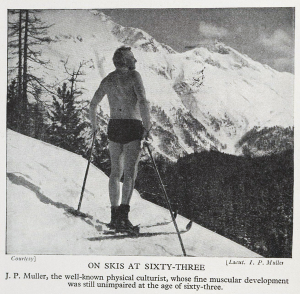
Typical posture of JP Müller exposing his body to the elements, at St Moritz
From: http://vintageski.tumblr.com/post/103983063903/fitness-guru-j-p-muller-shown-skiing-in-his
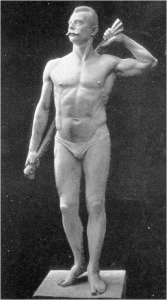
The bronze statue erected in honour of JP Müller in Denmark
From: http://perfecthealthathome.com/6-week-my-system-video-course-2
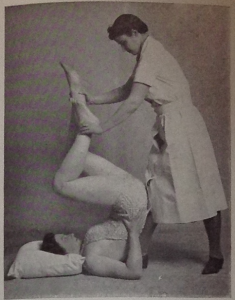
Minnie Randell facilitating an exercise
From her 1949 book ‘Training for Childbirth’

Barbara Mortimer Thomas shortly before she tragically died
From: http://wellcomelibrary.org/item/b16729006#?m=0&cv=0
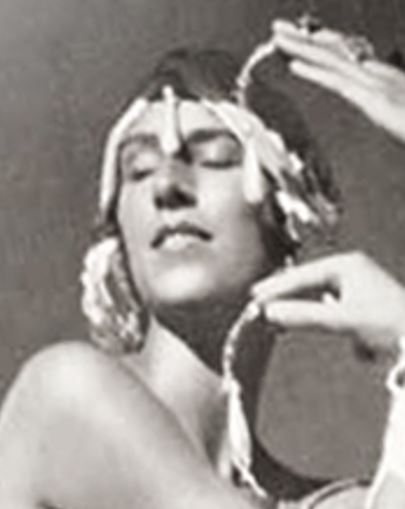
Margaret Morris exhibiting her physical and mental freedom
From: http://www.margaretmorrismovement.com/MargaretMorris
This excited but also frustrated me. For example, if I would have been taught Minnie Randell’s and Margaret Morris’s forgotten mind-body physiotherapy textbooks at university, I believe my career would have developed totally differently as well as my personal physical condition until recently. Fur-thermore, if physiotherapy schools worldwide would have continued to teach mind-body philosophy and exercises as a clinical and preventative tool like in England over a century ago, I believe the world would have been a better place today.
Due to the special challenge of writing a no-budget paper limited to 5000 words on any forgotten histo-ry, as might be expected, many forgotten co-pioneers of the ‘unnoticed’ turn of the 20th century MMB movement we researched were missed out and not mentioned. These include Géorges Hébert, Bess Mensendieck, Gustav Zander, Jessie Bancroft, Dio Lewis, FA Hornibrook, Richard Timberg, Edit Mezey and many others from all corners of the world. However, in retrospect one can internet-search each of these names and notice that they all talked about a similar exercise philosophy, prescribed similar exer-cises and promised the same physical and mental health for life. With this research project, we humbly discovered that it is all the same under the sun.
This brings me to raise a few issues regarding my personal mind-body guru and ingenious equipment inventor – Joseph Pilates, who emerged as the most successful Western mind-body pioneer. Thanks to his loyal followers, education schools and equipment manufacturers, Pilates is the most popular West-ern mind-body method today, enjoys widespread acceptance and influence and is continuously benefit-ing millions upon millions of people.
Our research led us to question whether Joseph Pilates was exposed to the philosophy and exercises of JP Müller, Minnie Randell or Kathleen Vaughan just before developing Contrology, between 1912-1914. All of them were operating in England at the time; Pilates (according to his historians) was an avid self-learner during those formative years, while Müller, Randall and Vaughan were famed mind-body educators vigorously promoting their methods all over the country. However, even if Pilates was exposed and influenced by these methods in England between 1912-1914, it might not have been criti-cal to the 1914-1917 conception of Contrology. This is because the philosophy and exercises were also similar to what Pilates learned as a weakly child in Germany by his gymnast father at their local physi-cal-culture gymnasium. We concluded in the paper that Pilates was likely exposed to the methods of Müller and Randell between 1912-1914 in England, but unless anyone has other information, the iden-tity of any specific teachers who inspired Pilates before developing Contrology as a concept method re-main a mystery.
Another issue we learned from the research, perhaps more worthy of discussion and clinical signifi-cance, was Pilates’ explicit decision to exclude functional standing exercises from the Contrology 34 exercise sequence. This was documented in his second and last official publication ‘Return to Life’ in 1945, which Pilates wrote as a 65 years old veteran. From a pure functional/developmental point of view, it sets Contrology apart from the other MMB methods we studied in this research whom all in-cluded a majority of functional standing exercises in their sequences.
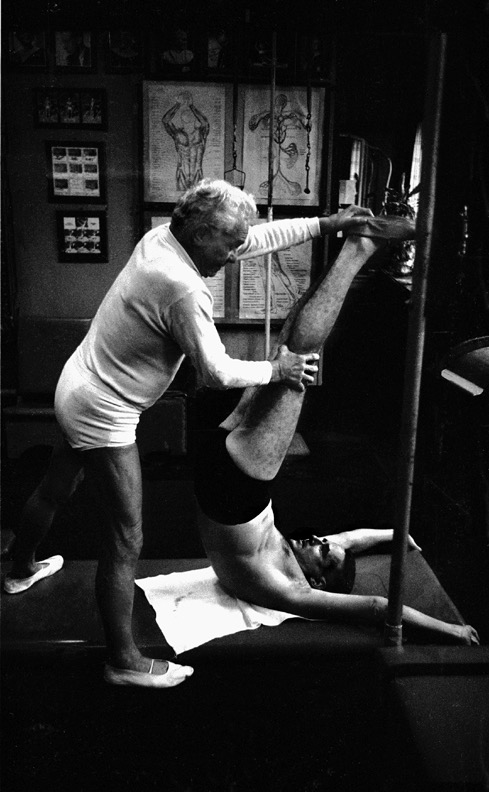
Joseph Pilates, the most successful Western mind-body pioneer
By permission of IC Rapoport
To conclude, conducting this research developed into an emotional multidirectional eye opening experi-ence; I learned about myself! The glorious past we discovered might serve to interpret our present situa-tion and as a result help dissolve our current dilemmas harmoniously. It might also bring current mind-body educators together and guide us with historical confidence towards a future in which mind-body exercise methods will be scientifically validated and officially promoted by healthcare stakeholders as gold standard. In this new-old order of things, Pilates instructors and physiotherapists have a special place of honour. Today we are the pioneers.
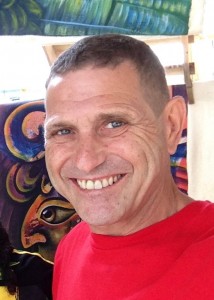 Jonathan Hoffman is an Australian educated manual physiotherapist, international mind-body educator, human movement researcher and published author from Tel Aviv, Israel. He has worked with profes-sional tennis, basketball and track & field athletes as well as world and European champion water-skiers. Jonathan is the developer of novel mind-body exercise methods and devices like the ATM2, Co-reAlign, Human Harmony and The Fun Machine.
Jonathan Hoffman is an Australian educated manual physiotherapist, international mind-body educator, human movement researcher and published author from Tel Aviv, Israel. He has worked with profes-sional tennis, basketball and track & field athletes as well as world and European champion water-skiers. Jonathan is the developer of novel mind-body exercise methods and devices like the ATM2, Co-reAlign, Human Harmony and The Fun Machine.
Publications
Peer reviewed articles:
• The origins of Western mind-body exercise methods. Physical Therapy Reviews, 2016.
• Re: Merger of models on clinical instability – Misleading for patients and clinicians. Manual Therapy, 2016.
• Expanding Panjabi’s stability model to express movement: A theoretical model. Medical Hypothesis, 2013.
Books:
• Being Fit, 2014.
• The Bongo Dogs, 2014.

